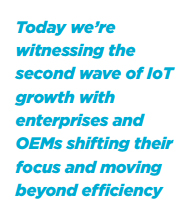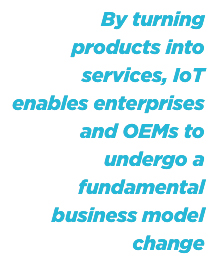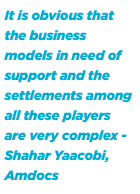The design of Internet of Things (IoT) solutions are strongly context aware, service-oriented focused, and multidisciplinary. This makes designing IoT solutions complex, often crafted for the specific context in terms of technological choices and business models.
From the point of view of IoT solution providers and the IoT community as a whole, the strategic dilemma is about defining an offer flexible enough to respond to the specific needs and the specific objectives of different contexts.
The definition of the offer can also require strategic partnerships with specialised players. It is not an easy journey, but a necessary one in order to be an enabler of value-generated IoT solutions. Here, Saverio Romeo, principal analyst at Beecham Research, talks to one of these travellers, Amdocs, to understand the hurdles and the tools for making that journey successful.
Amdocs has been very active in the M2M and IoT markets for a few years. Two years ago, the company launched an M2M Connected Device Platform and its cloud-based Connected Home Solution. And this momentum of innovation and attention towards the adopters and potential adopters of the IoT continues. Saverio met with Shahar Yaacobi, head of IoT Marketing at Amdocs, to discover how Amdocs is enabling users in designing value-driven IoT solutions and monetising those solutions.

Saverio Romeo [SR]: We see Amdocs becoming more active in the M2M and IoT markets. What is driving this and how do you see it developing further?
Shahar Yaacobi [SY]: Until recently, many service providers viewed M2M and IoT as a small business – not significant enough to invest in – so they used external, third party boutique solutions to manage their M2M/IoT business. But these solutions provided only connectivity. This approach proved to be costly with time, and also suffered from customer ownership issues. With the market growing and expanding to hundreds of vertical solutions, the level of complexity is growing. When complexity grows, and the scale expands with it, service providers look to proven solutions to help them take their lead back and generate more revenues. Notwithstanding, they also need to control their customers’ experience and provide value to the entire ecosystem.
SR: What dynamics do you see in the IoT market and where do you expect it to move to in the coming years?
SY: During the first wave of IoT, which is referred to as Machine-to-Machine (M2M), enterprises and original equipment manufacturers (OEMs) focused on improving operational technologies and optimising cost. This is an enterprise/industrial wave.
Today we’re witnessing the second wave of IoT growth with enterprises and OEMs shifting their focus and moving beyond efficiency. They’re offering business and consumer customers IoT services and the enabling connectivity, in addition to products. This wave is focused more on the consumer, but not only.
 Within the second wave, there are a number of issues to face such as the complexity of the value chain and the need for an ecosystem for delivering IoT solutions and how those ecosystems are managed. There is an interesting debate on how value can be enhanced such as the one-stop-shop experience. There is also a more mature debate on the plethora of connected devices. We have moved from the hype of a large number of devices to question how those numbers can be supported and managed. We also see a lot of attention around re-defining customer experience management in light of all those devices. In a nutshell, we see this wave as concentrated on the generation of new value, on the enhancement of existing value and how those can be achieved through innovative business models and new forms of customer engagements.
Within the second wave, there are a number of issues to face such as the complexity of the value chain and the need for an ecosystem for delivering IoT solutions and how those ecosystems are managed. There is an interesting debate on how value can be enhanced such as the one-stop-shop experience. There is also a more mature debate on the plethora of connected devices. We have moved from the hype of a large number of devices to question how those numbers can be supported and managed. We also see a lot of attention around re-defining customer experience management in light of all those devices. In a nutshell, we see this wave as concentrated on the generation of new value, on the enhancement of existing value and how those can be achieved through innovative business models and new forms of customer engagements.
There will be a third wave of IoT and it will revolve primarily around artificial intelligence (AI), where decisions will be made autonomously by machines based on real-time information, machine learning and advanced real-time Big Data technologies.
SR: The IoT seems to need consumers less than enterprise customers. How does Amdocs see the consumer IoT evolving? And what role is Amdocs playing?
SY: The business shift I described earlier in the second wave, where OEMs are starting to offer smart products and services instead of physical products only, opens the door for new business, engagement models and monetisation opportunities. Every OEM out there will need to evolve into a service provider in order to succeed in the IoT world. This process will take time, but we’re already seeing evidence for it. The largest OEMs are already offering smart devices, collecting data and creating value added services which improve quality of life. We see the consumer IoT wave as having much greater potential than the current industrial one. It will be more diverse with greater complexity and it will require every single player in the value chain to work together to produce a superior customer experience. Amdocs support our customers in monetising this wave, by providing the most flexible and enterprise-oriented platform, supporting the most complex engagement models. We call it the ‘servitisation’ wave.
SR: What is the ‘Servitisation’ model and what opportunity do you think it brings with it?
 SY: By turning products into services, IoT enables enterprises and OEMs to undergo a fundamental business model change. The essence of the servitisation wave is that enterprises and OEMs must evolve to become IoT service providers to secure recurring revenue and develop deeper ongoing relationships with customers, beyond the one time sale. They’ll need to offer services that fundamentally change the customer experience, allowing the end user to enjoy the visibility, transparency and insights produced from the flow of information generated by smart, connected devices. However, supporting IoT services comes with complex challenges and the problem is that enterprises and OEMs of all sizes lack the expertise, capabilities, knowledge and resources to make the servitisation shift.
SY: By turning products into services, IoT enables enterprises and OEMs to undergo a fundamental business model change. The essence of the servitisation wave is that enterprises and OEMs must evolve to become IoT service providers to secure recurring revenue and develop deeper ongoing relationships with customers, beyond the one time sale. They’ll need to offer services that fundamentally change the customer experience, allowing the end user to enjoy the visibility, transparency and insights produced from the flow of information generated by smart, connected devices. However, supporting IoT services comes with complex challenges and the problem is that enterprises and OEMs of all sizes lack the expertise, capabilities, knowledge and resources to make the servitisation shift.
SR: What particular value are you providing to communications service providers for connectivity management?
SY: Amdocs offers a connectivity device platform (CDP) which enables service providers to onboard partners quickly and efficiently, let them manage their own business operations and enjoy the most flexible business and engagement models. This solution is genuinely unique because it enables a secured business operation in contrast to the cloud third party solutions out there which force service providers to share revenues from connectivity management. It also can be a tightly coupled add-on to Amdocs’ CES portfolio, which would facilitate the utilisation of existing Amdocs B/OSS solutions with minimal setup. It’s an open platform and it’s available as a cloud service or on-premise, addressing mainly the wholesale segment, which today generates the majority of IoT revenues.
SR: Current communication service providers’ BSS are not really designed for IoT environments. How does Amdocs help CSPs in re-designing BSS systems for IoT requirements?
SY: As I mentioned earlier, IoT is driving enterprises and OEMs to move from product to service business models. In order to do that, they need help with billing, providing care and support, and most importantly they need to leverage the new data gathered to provide a better experience. IoT evolution is also leading the market to a potentially more complex value chain. So taking all of this into account, service providers have a real opportunity to monetise their assets by providing a solution for complex wholesale settlement between OEMs and enterprises and their business partners and complex consumer billing. For example, they can bill on behalf of a third party and facilitate white label billing, bifurcated billing, and consolidated billing. To help service providers fully monetise this opportunity, Amdocs launched the IoT Monetisation Platform, which is a BSS specifically designed platform to address current and future IoT needs.
SR: In what way is BSS for IoT different? How did you approach the development of your IoT monetisation platform?
SY: BSS for IoT is different from traditional telco solutions in many ways. First, IoT is essentially an enterprise play. So, when we were designing our IoT platform, we put the focus on the enterprise and the OEM to create a system which gives them a 360-degree view of their business and the ability to manage it independently. Second, the IoT data model and metrics are much different from those used by telecoms providers today. We also need to remember that many devices will have SIM cards, some of them will have eSIM but many will not have SIMs at all. In addition, because the value chain in the world of IoT is much more complex, we built the system to support many types of engagement models. I would also point out that we have addressed the need for a real-time system which supports wholesale and retail, in addition to prepaid and postpaid, and the ability to work globally, with numerous global players as well as customers roaming with their connected devices.
We have created a strong product using cutting edge technologies, which provides a lot of value to customers, with dozens of prebuilt business processes, using configuration only. It enables enterprises and OEMs to bill consumers for the purchase of IoT products and services directly, or via the consumer’s service provider bill. And let’s not forget seamless activation which allows customers to enjoy a wide range of connected devices anytime and anywhere.
SR: Apart from CSPs, what types of customers do you support in the IoT market?
SY: “Who is the customer?” and “What is the value we can bring them?” are two questions that lie at the heart of everything we do in this market. In the complex IoT ecosystem there are many different customers and each type has different needs. The trick is to identify relevant customers that Amdocs can provide value to by addressing their unique needs.
Various forms of service providers are our main customers and many of them are relatively ahead of the market in understanding and applying the servitisation model. Nevertheless, there are many enterprises and OEMs who have already acknowledged the huge opportunity created by IoT and have reach out to us for help in realising revenues either directly or through our service provider customers.
There are other giant players such as Samsung which has moved strongly into the world of IoT and understands the importance of providing a superior consumer experience. Samsung works with Amdocs to build global IoT solutions. These kind of cooperative partnerships are focused on providing an end-to-end (E2E) customer experience in activation, provisioning, billing and more.
Finally, IoT application developers often are the innovators in various sectors. They have great ideas and cutting-edge technology, but are struggling in distributing those ideas worldwide. We help those organisations to transform their ideas into ready-to-market solutions and bring them in front of relevant market players.
SR: Partnerships are key in the Internet of Things. How do you see these evolving and impacting successful monetisation of the IoT?
 SY: I think you have touched on a great point! The IoT spans thousands of vertical solutions and hundreds of thousands of players joining forces to provide those solutions. We are talking about application developers, content providers, app stores, connectivity providers, enablers for Big Data, application management, device management, SIM management, OEMs, enterprises, and their channels and distributors. And the list goes on in the very complex and fragmented IoT value chain.
SY: I think you have touched on a great point! The IoT spans thousands of vertical solutions and hundreds of thousands of players joining forces to provide those solutions. We are talking about application developers, content providers, app stores, connectivity providers, enablers for Big Data, application management, device management, SIM management, OEMs, enterprises, and their channels and distributors. And the list goes on in the very complex and fragmented IoT value chain.
It is obvious that the business models in need of support and the settlements among all these players are very complex. Our IoT Monetisation Platform manages all this complexity for both the wholesale and retail world, for hybrid solutions, for all industries, network types, both globally and locally.
SR: And, finally, how is it being part of an organisation that wants to be a protagonist in the IoT community? And, what do you expect to achieve in the next 2-4 years?
SY: Working on IoT in a global leader like Amdocs is both exciting and challenging. It’s great to be part of a group of enormously talented and experienced professionals who are focused on developing new technological solutions that will have a great impact on our lives. It’s exciting because the innovative technologies make this domain dynamic and fascinating across many other domains. It is also challenging because we try to predict huge changes in consumer, business and ecosystem behaviour and there are many unknowns. But our service provider customers continue to count on us to keep innovating and developing in this domain so they can leapfrog the competition.
At the end of the day, the one thing I am sure of is that Amdocs will remain among the leaders shaping this new IoT world and personally, I am excited to play a key role in it.










